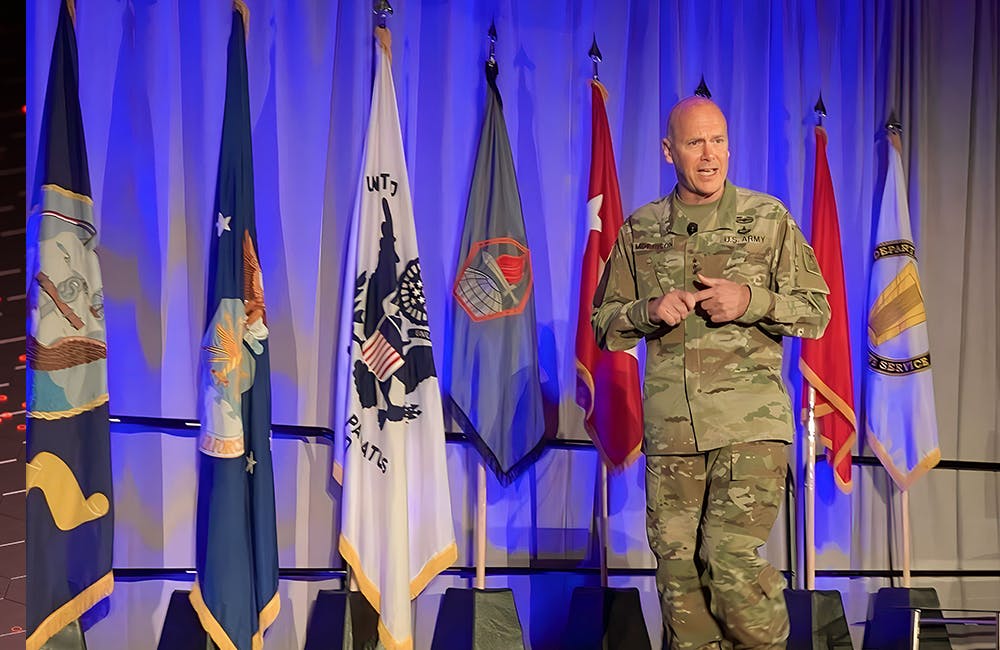Army Scales Up Its Bring Your Own Device Program to More Soldiers
BYOD program will let soldiers and DOD civilians securely access government systems through their personal devices.

The Army is preparing to roll out its Bring Your Own Device program to about 20,000 soldiers and civilian employees. It’s the next step in the service’s initiative as part of larger Defense Department effort to allow service members and civilians to work on their phones and home computers.
Lt. Gen. John Morrison, the Army’s deputy chief of staff, G-6, spoke about the program during an CyberCast interview at the Association U.S. Army Annual Meeting & Exposition. He explained the primary focus for Army officials is on analyzing user experience and security.
The Army has been testing technologies for the BYOD program for over a year, allowing the service to build a foundation for the program’s strategy and carry the successes of the initial rollout into the next stage. The program had an immediate operational impact, specifically with its National Guard partners. It also proved to have sufficient security, Army officials said.
“The ability to support operations, that usability from a user perspective, a capability that they like to use, and then having that security wrapper around it – all three of those we have rolled over into this next instantiation of the pilot, which is far broader than what we did the first time,” Morrison said.
Throughout multiple testing stages of the program, cybersecurity remained the primary component and key element for the Army.
“We really have sort of inside our Army flipped the paradigm of how we look at the problems. Instead of cybersecurity being something we bolt on at the end, that’s really not a good way to approach it. We bake it in on the front end,” Morrison said during the CyberCast interiew.
“With bring your own device, that’s exactly what we’ve done. And the technical instantiation is, while there’s an application that resides on your phone, none of the data does. It’s still all resident in the cloud with the appropriate defensive cyber watch over the top of it.”
Meanwhile, the Army is executing a Google Workspace pilot, one of the Army’s multiple IT modernization efforts, along with the BYOD program. The part of building out a cloud at the impact level 4 is over and the Army is currently evaluating how this effort fits into its future.
“I do have to emphasize that it is a pilot. It’s a fairly robust pilot,” Morrison said. “But as of about two weeks ago, all new accessions coming into the Army, we were issuing Google workspace accounts to include email, so that’s what they just start on. And then we’ll eventually populate most of the training base.”
This is a carousel with manually rotating slides. Use Next and Previous buttons to navigate or jump to a slide with the slide dots
-

The Next AI Wave Requires Stronger Cyber Defenses, Data Management
IT officials warn of new vulnerabilities posed by AI as agencies continue to leverage the tech to boost operational efficiency.
5m read -

Federal CIOs Push for ROI-Focused Modernization to Advance Mission Goals
CIOs focus on return on investment, data governance and application modernization to drive mission outcomes as agencies adopt new tech tools.
4m read -

DOD Can No Longer Assume Superiority in Digital Warfare, Officials Warn
The DOD must make concerted efforts to address cyber vulnerabilities to maintain the tactical edge, military leaders said at HammerCon 2025.
4m read -

Tracking CIOs in Trump's Second Term
Stay informed on the latest shifts in federal technology leadership as new CIOs are appointed and President Trump's second term takes shape.
6m read -

Inside Oak Ridge National Lab’s Pioneer Approach to AI
Energy Department’s Oak Ridge National Lab transforms AI vulnerabilities into strategic opportunities for national defense.
22m listen -

AWS Summit: Innovation Accelerates IT Delivery at DOD
Marine Corps Community Services is tackling outdated IT processes with agile development and cutting-edge cloud security to deliver mission-critical capabilities faster.
12m watch -

AWS Summit: NIST Secures High-Performance Computing Against Evolving Threats
NIST’s Yang Guo reveals the broad attack surface of high-performance computing and explains developing guidance and future-proofing security strategies.
9m watch -

Trump Overhauls Federal Cybersecurity with New Executive Order
The new directive aims to strengthen digital defenses while rolling back "burdensome" software requirements and refocusing AI security.
3m read -

AWS Summit: Forging Successful Cloud Modernization Partnerships
Industry leaders share insights on the critical role industry partnerships have in enabling government agencies to navigate procurement challenges for cloud and zero trust solutions.
24m watch Partner Content -

CISA's CVE Program and Why it Matters for Zero Trust
The vulnerability program provides the cybersecurity community visibility into software as part of a key pillar of CISA's zero trust model.
5m read -

Air Force, Coast Guard Talk Data Security Efforts for AI Development
The services' AI initiatives include efforts like creating clean training data, countering data poisoning and bridging siloed teams.
4m read -

DHS Secretary Urges Congress to Reauthorize CISA 2015
Federal leaders highlight CISA 2015's role in strengthening public-private partnerships and defending against evolving cyber threats.
3m read
















